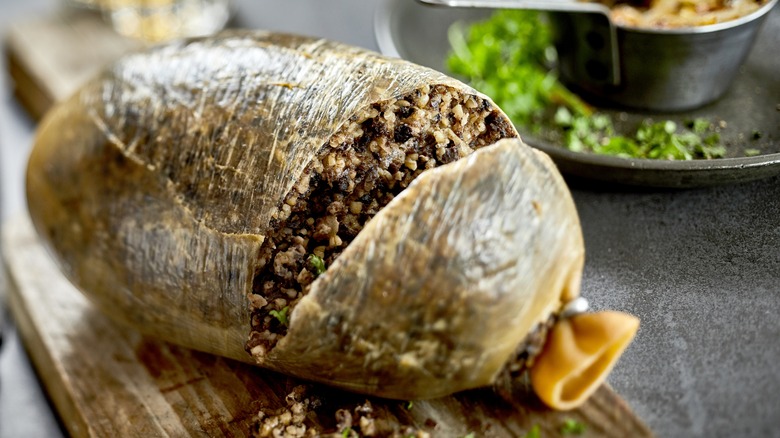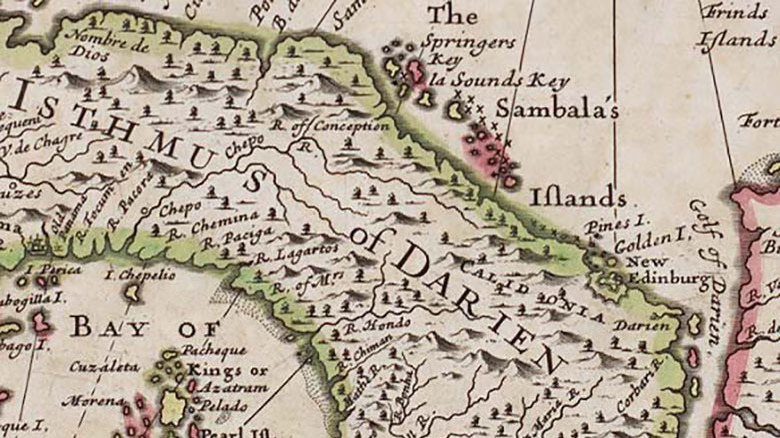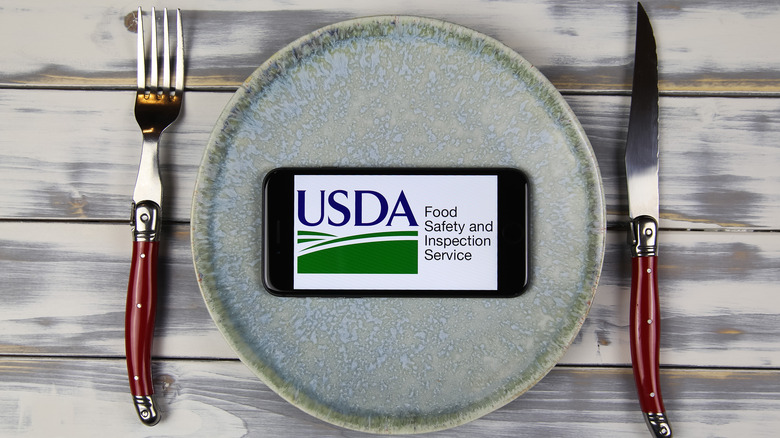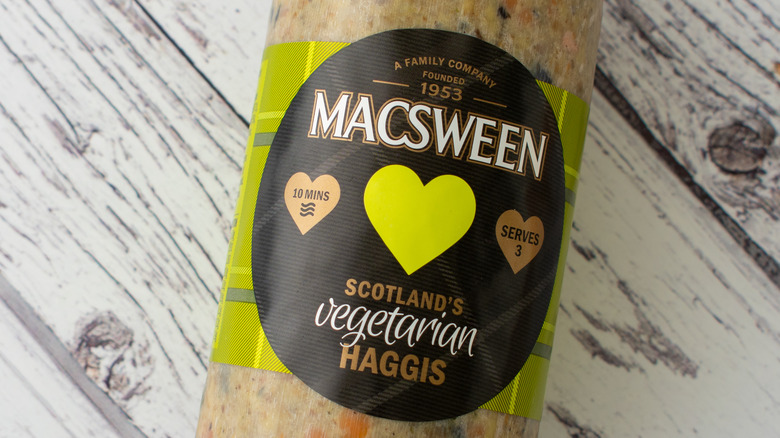The Untold Truth Of Haggis
Take a sheep's heart, lungs, and liver. Mix them with minced onion, oatmeal, suet, and a range of spices then stuff this grisly conglomerate inside the animal's own stomach. Cook until it resembles an over-inflated, brown balloon.
Doesn't sound very appealing does it? Yet this is how haggis, Scotland's national dish and an international phenomenon, has been made for centuries. Throughout this time haggis has evolved from a humble meal to the epitome of Scottish national identity, surpassing the caber toss, bagpipes, and long tartan kilts along the way. Yet, despite its celebrated nature, the history of this nuanced delicacy is shrouded in mystery, contention, and not a little folklore. Whispers abound concerning its potential English roots, disagreements have been had over its suitability for consumption, and many jokes have been made in reference to a reclusive animal that lopsidedly lopes around Scotland's lonely glens.
Now, in an attempt to separate fact from fiction, and understand why haggis has captured the hearts (and minds) of so many, we must leave our preconceptions by the wayside and dive headfirst into the rich, disorientating truth of Scotland's most treasured dish.
The first written record of Haggis is English, not Scottish
For those of us without a thorough understanding of Britain's anthropological history, the fact that the first known record of haggis was written in England might come as quite the shock. Indeed, this first mention of haggis by the "chief master cooks" for King Richard II in 1390, when coupled with another printed reference in "The English Hus-Wife" (1615) has formed the basis for an English claim for the dish's invention, as per The Guardian.
Of course, this claim is hotly contested by Scots and, as has been pointed out by History Today, the fact that these early texts come from England does not confirm that the dish in fact originated there. Add to the mix a perpetually fluid border between the two nations and pinpointing the exact birthplace of haggis becomes impossible. Whilst this lack of a definite answer has caused venomous dissent in the present, historically the origin of haggis was of little importance, with the dish remaining a culturally unspecific food for well over a century.
Haggis became associated with Scotland because of a devastating economic crash
For haggis to rise from the assorted cacophony of everyday meals, to the national food of Scotland, a great deal of socio-political drama had to unfold. During the late 17th century, a time period when Europe was gripped in a colonial race that saw swathes of the globe subjected to brutal imperialist rule, the Kingdom of Scotland saw an opportunity to gain wealth and influence by establishing a colony on the isthmus of Darien (modern-day Panama). This location would give the Scots an opportunity to monopolize trade between the Atlantic and Pacific oceans.
However, this endeavor, labeled the Darien scheme, did not go to plan. The majority of the 1,200 Scottish colonists died and their settlement, Caledonia, was abandoned after only seven months. As reported by the BBC between a quarter and a half of all the available wealth in Scotland was lost to the failed colonization project. With little other option, the economically crippled Scotland signed the Act of Union with England in 1707, waving goodbye to their independence.
The catastrophic economic fallout coincided with England's agricultural revolution. Just as food was becoming more plentiful for the English population, a large proportion of Scots could hardly afford to eat. Since haggis is made using the offal, amongst the most inexpensive cuts going, its popularity boomed in Scotland during the 18th century, exactly the same time when most English folk were turning their noses up at it.
Robert Burns instilled Scottish pride into haggis
With the economically crippled Scots forced to eat a dated dish of offal whilst the culinary possibilities expanded in England, it is not difficult to see how haggis became synonymous with poverty and barbarity. Indeed, after the Jacobite uprisings, and the increased anti-Scottish sentiment that followed, haggis even became a tool for the English to stereotype and dehumanize the Scots.
Then entered poet Robert Burns, future national poet of Scotland, and his famous work "Address to a Haggis". In this mock-heroic poem Burns took the abused haggis which had been weaponized by the English and, miraculously, transformed it into "The great chieftain o' the pudding-race" a symbol of a hardworking, proud, and robust Scotland.
The elevation of haggis to Scotland's national dish has been cemented by the traditional Burns night supper, which occurs on the 25th of January; Burns' birthday. The dinner starts with a traditional Scottish soup, often Scotch broth or cock-a-leekie, before the haggis is brought in preceded by a bagpiper. "Address to a Haggis" is then read before the dish is served with neeps (turnips), tatties (potatoes), and of course, a dram of whiskey.
Foods similar to haggis date as far back as Ancient Greece
We have already seen how the origins of haggis within the British Isles are hotly contested. Yet, the act of encasing the offal of an animal in its own stomach is an ancient tradition that many cultures have a history of utilizing. One historical culture which took to making foods similar to haggis was the Vikings, with a prominent Icelandic delicacy slátur (via Iceland Magazine) bearing an extremely close resemblance to Scotland's national dish. Other similar products, such as Lungmos, can be found across Scandinavia. This has led many experts to suggest that haggis was in fact brought to Scotland via the longboats of Norse invaders. A claim which was backed by celebrity chef Clarissa Dickson Wright.
Furthermore, it is known that the Ancient Romans used to stuff an animal's stomach and lungs with offal before boiling it. Apicius, a Roman cookbook possibly written by a Roman gourmand named Marcus Gavius Apicius in the 1st century A.D., contains a recipe for pig paunch which involves stuffing the swine's stomach with "three brains — the nerves removed — ... raw eggs, ... nuts, whole pepper, and sauce to taste. ... lovage, silphium, anise, ginger, a little rue."
Indeed, offal stuffed foods are popular in ancient writing and literature with a food uncannily similar to haggis even being mentioned in book 20 of Homer's Odyssey, an ancient Greek epic composed between the 8th or 7th century B.C.
Haggis has been banned in the US since 1971
In 2004 the Scottish Parliament estimated that there were more than 20 million Americans with Scottish descent. Furthermore, an incredible 34 of U.S. Presidents claimed some sort of Scottish descent (per Scotland.org). With such statistics it is unsurprising that the U.S. has a taste for Scottish produce; in 2019 alone Scottish exports to the U.S. were worth £4.3 billion.
However, due to traditional haggis containing sheep's lung, the dish in its original form has not contributed to this boom. This is because, as previously reported by Mashed, the U.S. Department of Agriculture has banned the use of livestock lungs as food. This ban is in place due to the potential dangers associated with eating animal lungs, as explained by Dr. Jonathan Resiman to Gastropod.
"They [the USDA] found pollen that the animals had inhaled, they found fungal spores in there, they even found some stomach contents that had ended up in the lungs. And these contaminants made them think that lungs were not fit for human consumption."
However, this need not mean a perpetual dearth of haggis consumption in the U.S. Similar offal bans remain in place in Canada, and MacSween's, a famed, Edinburgh-based haggis producer, has manufactured a haggis that is compliant with these rules. And with President Joe Biden recently lifting a 32-year-old ban on British lamb imports, it is hoped that MacSweens can come up with a similar solution for the U.S. in the near future.
Global appetites for Haggis are only increasing
Whilst it remains a very Scottish delicacy, haggis has been growing in global popularity over recent years. Edinburgh-based haggis producer MacSween delivers to seven international markets, whilst other producers have started exporting to untapped markets such as Greece and Ghana, as per gov.uk. With Hong Kong labeled the fourth biggest haggis market in 2020, there can be little doubting the global appeal of this dish.
However, move closer to home and the story becomes a little more complicated, and dare we say, embarrassing. In 2020, it was revealed (as reported by The Courier) that in the United Kingdom the majority of haggis is no longer sold in Scotland, but south of the border. Simon Howie, a Perthshire-based butcher whose sales in 2020 accounted for 53% of all haggis sold for Burns night celebrations, experienced a 6% increase in sales in England and Wales. This means a whopping 60% of all Howie's sales, equivalent to 1.2 million individual portions, were delivered to England and Wales alone. This isn't to say that haggis is no longer being eaten in Scotland itself. On the contrary, per thescottishbutcher.com the average Scotsman still consumes 14.7kg of haggis per year, without even taking into account Burn's night and Hogmanay; the two nights when haggis is consumed most widely.
Selkirk Hill holds a famed annual Haggis Hunt
Despite the dish's growing popularity there still remains a great deal of misunderstanding when it comes to haggis. This is in part due to a seemingly ubiquitous Scottish pastime; spreading haggis-related misinformation. A quick google search of "wild haggis" will provide some entertaining results. Blurry pictures, how-to hunting guides, and even sanctuaries for the elusive "creatures."
The old joke that the haggis is in fact a furry, rodent-sized animal with legs on one side longer than the other to aid living on the steep Scottish mountains, is taken so seriously in places that several annual haggis hunts have become tradition. Most famed of these is undoubtedly the Selkirk Hill hunt which welcomed 567 participants in 2020 alone.
Amusing as this tradition may seem to the local populace, the long-running national joke has led to many tourists actually believing the haggis is a wild, and frequently culled creature. An online survey run by haggis producer Hall's of Broxburn, and reported by The Guardian, found that one-third of U.S. tourists thought that the haggis was indeed an animal, with a further 23% claiming they could catch one.
Haggis Hurling has become a Scottish (and global) sport
Now, the fact that the caber toss, world stone skimming championship, and coal carrying championships all originated in Scotland should indicate that Scots have a particular affinity for more obscure athletic pastimes. Yet, if any doubt remains in your mind then you need look no further for confirmation than the sport of haggis hurling. This particular sport has grown in popularity over recent decades, and involves participants standing on a platform (usually an overturned whisky barrel) and throwing a cooked haggis as far as possible. Sounds easy, right? Well, you would be wrong, as the haggis must remain intact, and thus edible, after landing. This means no bursts, no tears, and no holes. The current world record stands at 217 feet, and was thrown by Lorne Coltart in 2011 Milngavie Highland Games.
The origins of haggis hurling are just as peculiar as the sport itself. The supposedly ancient sport was rumored to have been based upon a 17th-century custom where women tossed a haggis lunch to their husbands working in Scotland's bogs. Upon learning of its historical connotations the sport was set for revival at the 1977 Gathering of the Clans after Rob Dunseath, an Irishman, posted an advertisement in a newspaper. Decades later, and with the sport being played across the globe, Dunseath revealed the whole sport was a hoax created, as he stated, to see just how gullible the Scots were.
Vegetarian and vegan haggis alternatives are booming in popularity
The sausage roll and haggis have much in common. Both are synonymous with their home nation, both are closely associated with comfort, and both are equally well suited to the growing demand for meat-free alternatives.
As was seen by the sales mania resulting from popular fast food chain Gregg's vegan sausage roll release in 2019, there is a burgeoning market for plant-based meat alternatives. A trend that is only set to increase as younger generations, who are statistically more inclined to partake in meat-free meals and diets, come to dominate the market. This notion has not been lost on Scotland's leading haggis producers. As reported by The Scotsman, Simon Howie and MacSween's have experienced rapid growth in the demand for meat-free haggis, with both putting it down to environmental concerns, healthy eating schemes, and campaigns such as Veganuary. MacSween's was the first to commercially launch a vegetarian haggis in 1984, and the same product now constitutes 25% of their overall haggis sales.
Perhaps even more excitingly, vegan and vegetarian haggis may be the product that finally unlocks year-round haggis sales for Scotland's haggis producers, as the dish can finally offer a satisfactory Sunday roast alternative for non-meat eaters, and a healthier haggis alternative for those looking to minimize their saturated fat intake.
Celebrated chefs are modernizing the dish
The phrase "if it's not broken then why fix it?" tends to not carry much weight in the culinary world. Professional kitchens are forever on the hunt for something new, and more often than not this "new" comes through reinventing the old. This has most definitely been the case for haggis served in a professional setting, with a whole host of chefs grabbing headlines for their wacky take on the great chieftain o' the pudding-race. Most prominent amongst these is perhaps Paul Wedgewood, whose flagship Wedgewood the Restaurant has been tipped for a Michelin star. In 2015, Wedgewood traveled to Lima, Peru to work with renowned chef Mitsuharu Tsumura at his mercurial restaurant Maido, which was recently ranked as the 7th best restaurant in the world. By combining his passion for utilizing local ingredients and his well-documented love of haggis, as reported by The Scotsman, Wedgewood set about creating a haggis with one of Peru's most favored meats, guinea pig.
However, Wedgewood is not alone in reinventing haggis. Fred Berkmiller, who runs L'escargot Bleu also in Edinburgh, took his inspiration for a reworked haggis from a little bit closer to home by incorporating horse offal in place of the traditional sheep. A popular ingredient in France, where Berkmiller was born, horse offal creates a very different kind of haggis due to its light, tender flavor, and almost fat-free nature.
The health aspect of haggis is contested
Health might not be at the forefront of your mind when you sit down for Burns supper, it is after all a yearly occasion. But for those who eat haggis on a regular basis, a nutritional breakdown of the dish provides valued information.
Due to the large amount of offal present in haggis, it is unsurprisingly rich in vitamins and minerals, as reported by MyProtein. Both its high mineral and vitamin content contribute towards maintaining a healthy immune system and assisting with nutrient uptake. Dr. Laura Wyness, a fixture on BBC Two's "The Food Detectives" concurs, stating that the liver "is high in vitamin A, vitamin B12 and folate". She does however coincide that haggis is high in fat, saturated fat, and salt.
In fact, it's these properties that led Scotland's 2006 deputy education minister to urge Scottish families to serve haggis, and other processed meat once a week at most (per The Guardian). The report which aimed to tackle childhood obesity levels and was created by NHS Scotland ranked the healthiness of the famed dish alongside turkey twizzlers and other highly processed foods. This comparison angered many haggis suppliers with Alan Pirie, reigning Scottish haggis master at the time, stating "It's made of all natural ingredients – there's no rubbish in it at all. To compare it with processed meat like chicken nuggets or hot dogs is just ridiculous. It's a big knock for us for it to be compared to those".
John MacSween was the godfather of modern haggis
The name MacSween is synonymous with haggis with their shared history tracing its roots all the way back to a butcher's shop in 1950s Edinburgh. After the founder of the business Charlie MacSween passed away in 1975, MacSween's was handed down to his son John who, in 1983, saw an opportunity to specialize in the production of haggis.
After John's death in 2006, his legacy of selling high-quality haggis that is suitable for everyone has been continued by his children Jo and James who have successfully launched a range of new, and award-winning products which include vegetarian haggis, one-minute microwavable haggis, and haggis meatballs. MacSween's has also made history in 2017 after becoming the first and only exporter of haggis to Canada since 1971 (per gov.uk). This was only made possible after developing a new recipe that abided by Canada's strict food safety regulations. Replacing the lamb's lung with lamb's heart to achieve a similar rich taste and crumbly texture.
Then-economic secretary of the Scottish Parliament Keith Brown was ecstatic with the successful exporting of haggis after many years stating that "this development is an indication of the increasing interest in, and love of, Scottish food and drink produce in North America". Of course, the potentially enormous U.S. haggis market remains largely untapped with MacSween's currently only exporting a vegetarian haggis, marketed as "Scottish Veggie Crumble," to the states.












